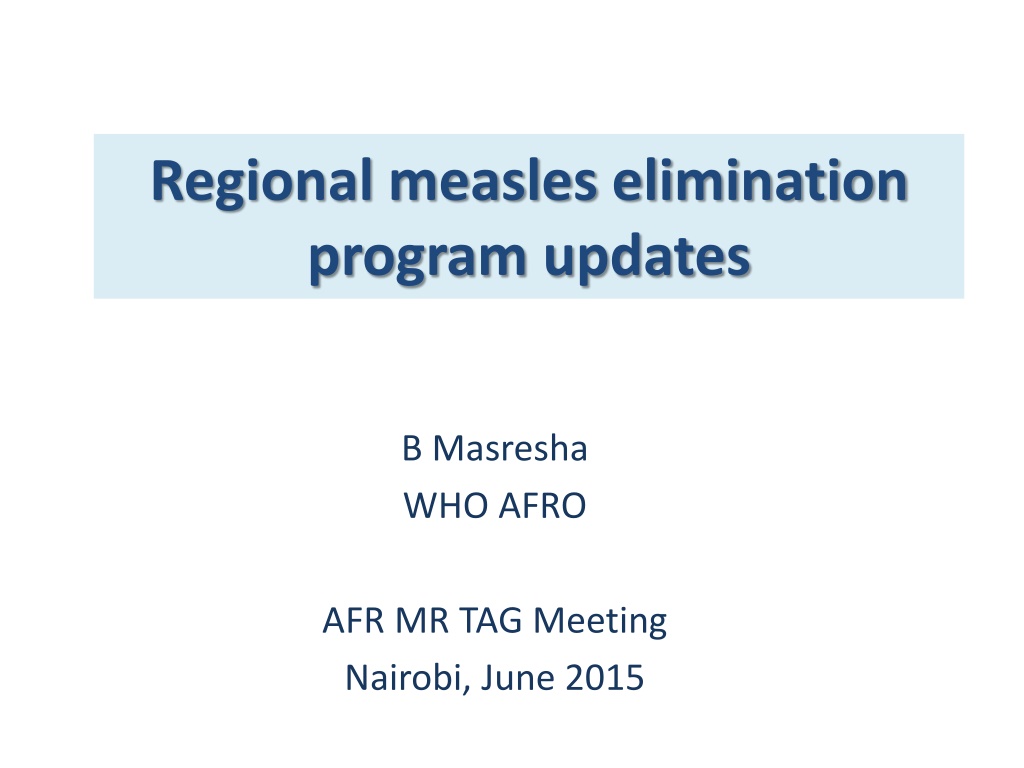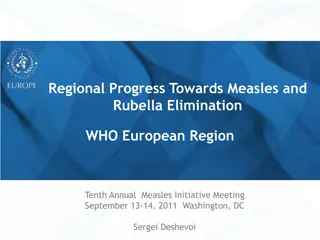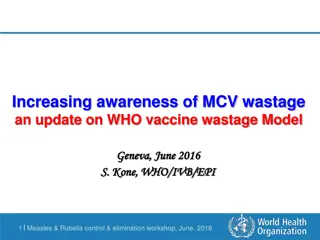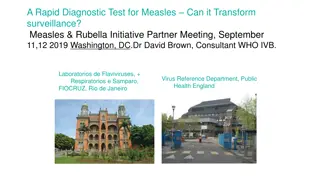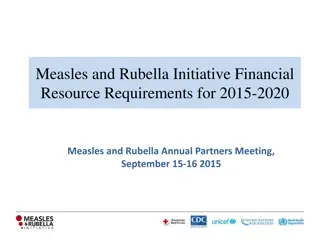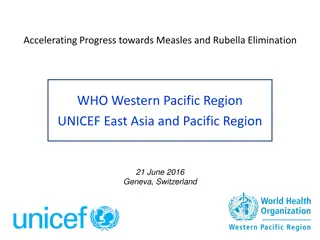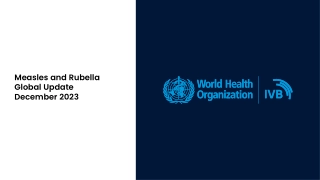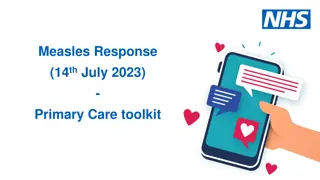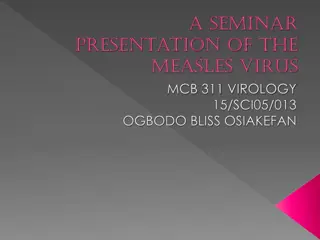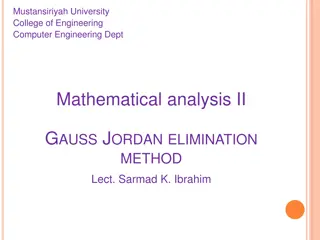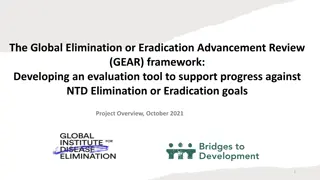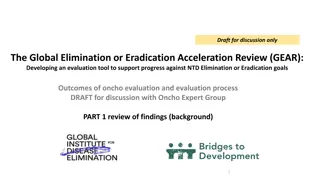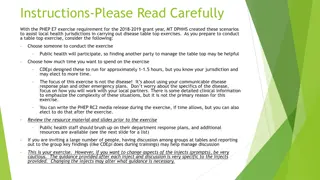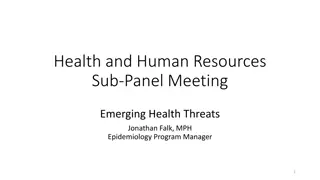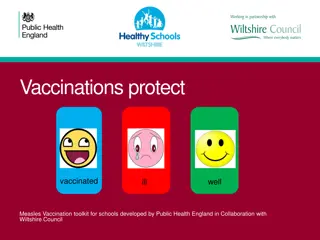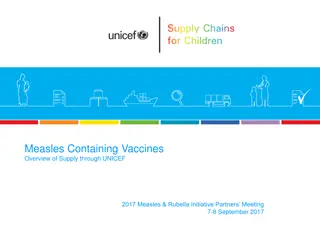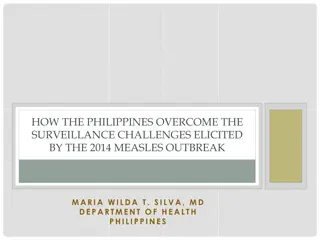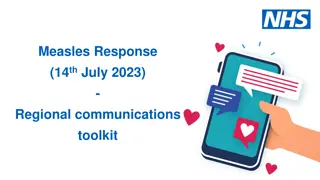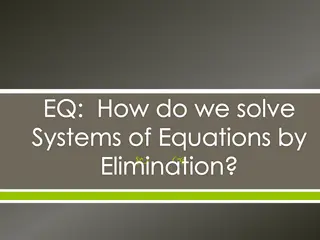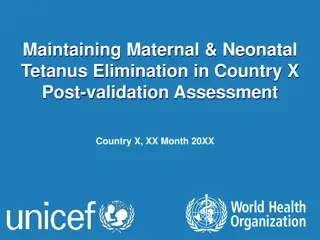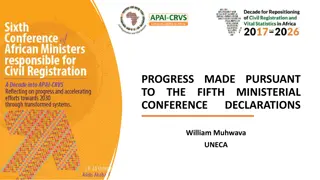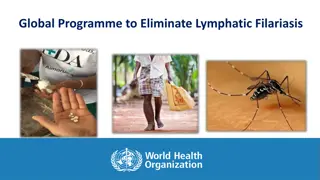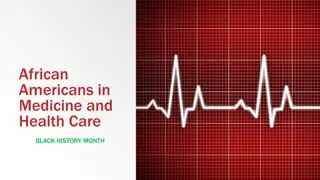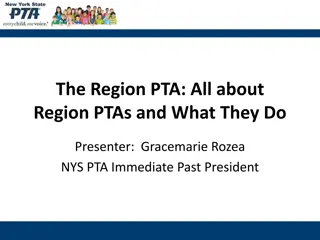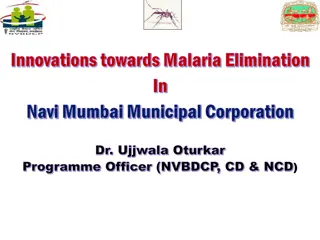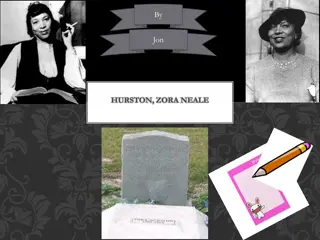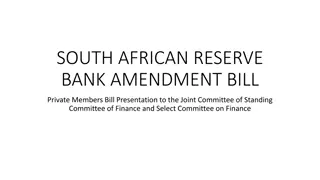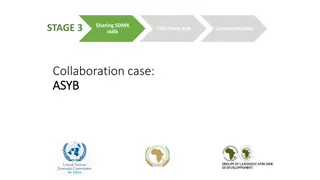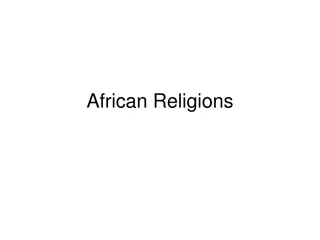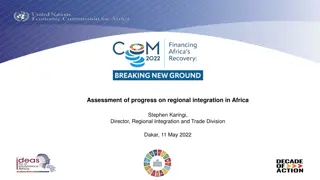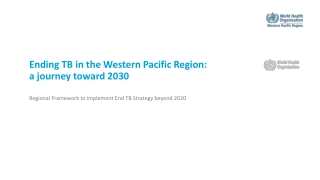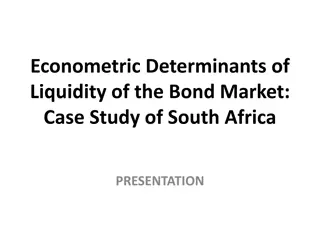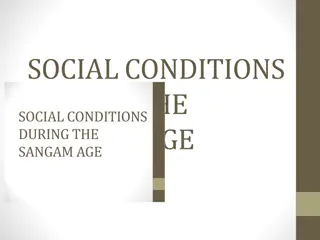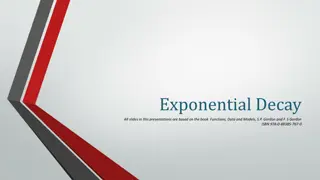Progress Towards Measles Elimination in the African Region
The data presented showcases the progress and goals of measles elimination efforts in the African Region, focusing on targets for routine immunization coverage, introduction of MCV1 and MCV2 vaccines, supplementary immunization activities (SIAs), surveillance performance, and overall advancements towards regional measles elimination by 2020. The visuals illustrate achievements, challenges, and strategies implemented to reach the set goals.
Download Presentation

Please find below an Image/Link to download the presentation.
The content on the website is provided AS IS for your information and personal use only. It may not be sold, licensed, or shared on other websites without obtaining consent from the author. Download presentation by click this link. If you encounter any issues during the download, it is possible that the publisher has removed the file from their server.
E N D
Presentation Transcript
Regional measles elimination program updates B Masresha WHO AFRO AFR MR TAG Meeting Nairobi, June 2015
Outline Measles elimination targets Routine immunisation coverage MCV2 introduction MR introduction SIAs quality and financing Surveillance performance Overall progress towards Regional measles elimination Next steps
African Regional goal to achieve measles elimination by 2020 >95% MCV1 coverage at national and district level > 95% SIAs coverage in all districts. incidence of < 1 case / 106 population /year (excluding imported cases). Achieve the surveillance performance targets
MCV1 coverage WHO UNICEF estimates, and number of countries reaching > 90% coverage. 2000 2013. (N=47)
Status of MCV2 introduction in AFR. May 2015 19 countries with MCV2 3 countries approved / pending approval by GAVI and introducing in 2015
MCV1 and MCV2 reported admin coverage. 2014 Eritrea and Kenya did not report MCV2 coverage in JRF in 2014!
Status of MR introduction in AFR. May 2015. 7 countries with MR in routine EPI BFA did MR SIAs, and will introduce MR in EPI in 2015 MR SIAs in 2015 in CAE, GAM, KEN, NAM, ZIM
Measles SIAs in AFR. 2001 - 2014 100 90 Number of children reached in millions 80 70 60 50 40 30 20 10 0 2001 2002 2003 2004 2005 2006 2007 2008 2009 2010 2011 2012 2013 2014 Catch-up SIAs Follow-up SIAs A total of 774 million reached in SIAs since 2001.
Funding for SIAs in 2014 - 2015 MRI funding for ops thru WHO (incl GPEI) Local Age target Source of funding GAVI funding Country contributions 9 M - 9 Y Self $245,687 $14,856,335 Angola Benin BFA Chad CIV DRC (Feb) DRC (April) DRC (July) Liberia Mali Mauritania S Sudan Tanzania Togo 9 - 59 M MRI $409,834 $183,472 9 M - 14 Y GAVI $11,574,660 $0 $30,000 9 - 59 M GAVI / MRI $2,134,652 $2,470,183 $697,247 9 M - 14 Y MRI $2,869,333 9 M - 9 Y GAVI / MRI $1,408,052 9 M- 9 Y GAVI / MRI $850,066 $288,506 9 M - 9 Y GAVI / MRI $1,529,676 9 M - 9 Y MRI $158,793 9 M - 14 Y MRI $2,394,890 $1,112,894 9 - 59 M MRI $223,333 $200,000 9 - 59 M MRI $2,610,653 9 M - 14 Y GAVI $28,826,693 $120,000 $346,867 9 M - 9 Y MRI $184,000 $50,916 $15,290,501 $17,766,237
Local resources for measles SIAs per child targeted. 2014
Key Measles Surveillance Performance Indicators, African Region 2011 end April 2015. PERFORMANCE INDICATORS Number of reporting countries 2011 2012 2013 2014 2015* 43 43 43 44 44 Number of suspected measles cases reported 74,896 55,717 101,196 67,002 27,085 Number of confirmed measles cases 32,323 20,935 69,910 37,394 11,355 Non-measles febrile rash illness (target >2/ 100,000 population ) 4.4 3.7 2.9 2.6 2.6 % districts reporting at least 1 case with blood sample (target >80%) 81% 84% 78% 77% 56% Incidence of confirmed measles per million population 42 27 76.9 39.5 11.8 * Info as of end April 2015
Scatter plot of surveillance performance according to the two principal indicators. 2014
Incidence of confirmed measles in AFR. Case based surveillance data. 2014. 22 of 44 countries met the targets for both of the main surveillance performance indicators in 2014.
Measles incidence. AFR. 2014 Incidence per million population # (%) of countries Population % of total regional population 12% <1 12 (27%) 112.2 1.0 4.9 9 (20%) 196.9 21% 5 9.9 6 (14%) 137.8 15% 10 19 5 (11%) 128.5 14% 20 99 9 (20%) 258.3 27% 100 and above 3 (7%) 113.2 12%
MCV1 coverage (WHO UNICEF estimates) and official case reports (JRF). AFR. 2001 - 2013 64% of case reports in 2010 = from Malawi 69% and 68% of case reports in 2011 and 2012= from DR Congo 63% cases in 2013 = Nigeria 89% cases in 2013 = 4 countries ( NIE, ANG, ETH, UGA)
Age pattern of confirmed measles the example from Ethiopia. 2015 N= 6955 confirmed cases as of epi week 18, 2015
Age pattern of confirmed measles the example from Nigeria. 2015 N= 1253 confirmed cases as of epi week 18, 2015
Introducing measles rubella elimination standard surveillance Guidelines finalised along with specific indicators Training done in Rwanda, Botswana, Swaziland Consensus built in Seychelles Next in Eritrea, Ghana, Gambia, Mauritius, Cape verde, Algeria
Reduction in estimated measles deaths by WHO Region. 2000 - 2013
Progress towards Regional measles elimination >95% MCV1 coverage at national and district level: 8 of 47 countries in 2013 (WUENIC) > 95% SIAs coverage in all districts: 7 of 26 countries in 2013 - 2014 incidence of < 1 case / 106 population /year: 12 of 44 countries in 2014 Achieve the surveillance performance targets: 22 of 44 countries in 2014
Categorising countries according to levels of program implementation Strong program, very low incidence sustained, nearing elimination (ALG, BFA, CAV, RWA, ERI, GAM, GHA, MAS, SEN, SEY, STP, ZIM) 12 countries Increase MCV2 coverage, MR intro, elimination-standard MR surveillance, space SIAs wider, start work on national verification of elim n, advocate for regional leadership of measles elimination Coverage or surveillance gaps, on track for elimination, (BEN, BUR, BOT, CAE, CIV, COM, CON, LES, MAD, MAL, MAU, MOZ, SWZ, TAN, UGA, ZAM) 16 countries Wide age-range SIAs, MCV2 intro, address surveillance gaps
Categorising countries according to levels of program implementation (2) Larger countries, various forms of program gaps. (GUI, KEN, MAI, NAM, SOA,TOG, LIB, SIL) 8 countries Improve quality of SIAs, Wide age-range SIAs, MCV2 intro Very challenging countries, insecurity, high incidence and frequent large outbreaks, leadership gaps. (ANG, CAR, CHA, DRC, EQG, ETH, GAB, GUB, NIE, NIG, SSD) 11 countries Advocate for better pgm ownership, RI strengthening, regular high quality SIAs targeting wider age gp, ..
Major challenges Routine coverage not improving in countries with large populations Measles elimination not yet a national priority in many countries Lack of timely funding for [wide-age range] SIAs Limited funding for measles-rubella surveillance and lab activities, esp as AFR scales-up to elimination mode surveillance Weak quality investigation/ documentation of outbreaks
Next steps Big advocacy drive needed using the opportunity of the momentum and excitement of interruption of WPV transmission the Ministerial level RVAP meeting in Nov 2015 Next RC meeting Scale up MR elimination-standard surveillance Ensure policies are updated and align with implementation guidelines Initiate developing the guidelines and structures for national verification of elimination
